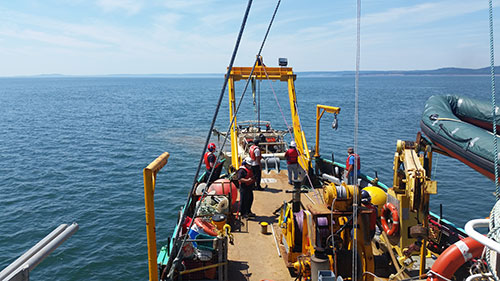FAST Underwater Platform Completes Successful Sea Trial

Efforts to understand the unique environmental conditions in the Minas Passage of the Bay of Fundy are moving forward.
After a 27-day sea trial, a team comprised of staff at the Fundy Ocean Research Center for Energy (FORCE) working in concert with crew on the Dominion Victory have successfully recovered an underwater monitoring platform, known as FAST-1.
“To explore the energy potential in the Bay of Fundy responsibly, we have to understand it,” said FORCE general manager Tony Wright. “We’re building a series of subsea instrument platforms that will give us a clearer picture of what’s happening at the FORCE test site.”
The platform was retrieved in mid-July, and analysis of sensor data is now underway. Reliable site data is critical to all aspects of in-stream tidal energy development, including both turbine design and understanding any effects on the marine ecosystem.
Fast -1 recovered by Dominion Victory. Photo credit: FORCE
The Fundy Advanced Sensor Technology (FAST) program encompasses three separate underwater platforms, onshore radar, meteorological instruments, and a tide gauge. Headlining the program is FAST-1. At 4.5-tonnes and 4-metres in length, this platform is designed for frequent deployment and recovery to enable instrument testing and monitoring.
The platform’s current sensor array includes:
- Acoustic Doppler current profilers (ADCP) and the Vectron (measuring current speed and turbulence)
- Acoustic zooplankton and fish profiler (assessing zooplankton and fish density and depth distribution)
- Water quality sensors (measuring water conductivity, temperature, and salinity)
- Optical sensor (measuring sedimentation size, distribution and volume concentration using laser diffraction)
- Tide, turbidity, and current sensors
- Orientation sensor (measuring pitch, roll and heading – crucial to platform placement and the analysis of all other instruments)
These include the Aanderaa SeaGuard Platform, the Sequoia LISST, ASL Acoustic Profiler, Nortek Signature 500, and the TRDI Sentinel V s100.
Mr. Wright added: “These sensors will add to our understanding of site conditions, including the presence and vertical distribution of fish at the site, and help inform our research and monitoring programs as they continue to evolve.”
“Many ocean sensors have not been designed to operate in extreme high flows like those at the FORCE site in the Minas Passage,” said FAST lead Andrew Lowery. “The platforms are designed to help us advance our ability to capture data in these challenging, complex conditions.”
The FAST program is in addition to FORCE’s regulated environmental effects monitoring programs, which in 2016 focus on fish, lobster, marine mammals, seabirds, and marine noise. Many companies and several Atlantic Canada universities have been involved in work with the FAST platform. A partial list of institutions and businesses and their contributions includes:
- ABCO Industries (Lunenburg, NS) – large platform construction
- Acadia University – tidal current modeling Acadia University (Wolfville, NS) – fish distribution analysis; acoustic sensor work
- blue C designs (Halifax, NS) – custom onboard orientation technology with acoustic interrogation design
- CulOcean Consulting (Halifax, NS) – hydrodynamics (currents, turbulence, and wave) analysis
- Dalhousie University (Halifax, NS) – sediment analysis
- Dalhousie University, (Halifax, NS), Memorial University (St. John’s, NL) – acoustic Doppler Instrumentation innovation (the Vectron)
- Dominion Diving (Dartmouth, NS) – project component mobilization and assembly
- Dynamic Systems Analysis (Halifax, NS) tidal flow loadings and platform deployment modeling
- Earle MacAloney Excavation Ltd. (Parrsboro, NS) on-land platform management
- EMO Marine Technologies Ltd. (Dartmouth, NS) – fibre optic system design and build
- JASCO Applied Sciences (Dartmouth, NS) – passive acoustic science and technology
- Lenkeek Vessel Engineering (Dartmouth, NS) – platform final design
- Ocean Networks Canada (Victoria, BC) – initial concept development, ongoing online data management
- OceanMoor Technical Services (Falmouth, NS)
- OceanWorks International (Vancouver, BC) – preliminary design of FAST-1 platform and recovery system
- Open Seas Instrumentation (Musquodoboit Harbour, NS) – FAST-2 platform design and construction
- Seaforth Geosurveys Inc. (Dartmouth, NS) – platform deployment location evaluation and selection
- Velocity Machining & Welding (Dartmouth, NS) – high precision components for FASTplatform fabrication
- WPV Designs (Fall River, NS) – instrument mount fixtures design and fabrication
FORCE is Canada’s lead test facility for in-stream tidal energy technology, located in the Bay of Fundy. As a not-for-profit research lab, FORCE collaborates with government, industry, academia and the public to better understand if this technology can play a safe, effective role in Canada’s energy future. Since 2009, FORCE has built the electrical infrastructure to allow in-stream devices to deliver power to the provincial grid, and in partnership with academic and research institutions, invested $15 million in research, monitoring and the Fundy Advanced Sensor Technology program, increasing understanding and scientific knowledge of the Minas Passage. FORCE receives funding support from the Government of Canada, the Province of Nova Scotia, and participating developers.

